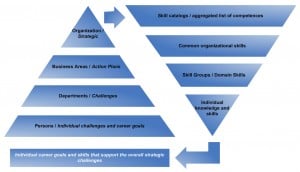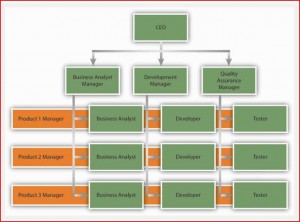In the last MGT598 class, we discussed the various advantages and disadvantages of the different types of organizational structures and worked through related issues in the Moss and McAdams case study. The company for which I work shifted from a functional hierarchy to a hybrid matrix within the last year, which concluded in a mixed reporting structure throughout the company. Some teams remained grouped by functionality, some were grouped by client or project, and more still were subject to both.
I am a manager for a functional group that spans many of the clients, so I found myself facing a lot of the same issues from the case study such as stated in the textbook:
1) Dysfunctional conflict – client managers would argue over whose work was the most difficult to obtain the best resource
2) Limited technological expertise – when resources have to be assigned to each client instead of from a pool it becomes more difficult to balance varying levels of expertise
3) Poor integration – finding resources to backup or replace those on vacation or sick leave is harder due to the lack of flexibility
In many instances I found that I had inherited the worst of both worlds without any of the advantages, combined with lower headcount following the recession there has not been any recruiting effort to replace or train to meet the changing needs of the clients.
Where should I start to address conflicts with the new reporting structure?
Previously I had established a backup structure which could be easily adjusted as all resources were in a pool under my control. With the new structure, resources would have to be assigned on a dedicated basis. I first performed interviews with the resources to create a job analysis document – hours, difficulty, and flexibility for the workload for each client. I then created a skills document to reflect the levels of talent and experience and produced a skill gap analysis to present to the client managers.

Having the additional input of the managers was important, as there were many interpersonal factors I had not considered such as past grievances and other incompatibilities. But above all it provided me substantial proof to get a consensus that an additional resource was needed to compensate for the loss of flexibility available for the change. The documents I created allowed me to translate the skills and requirements into a requisition for a new hire and I was able to meet the clients’ needs.
But where were the organizational considerations?
It was clear that the decision to change the organizational structure was driven by a desire for control from the higher-ups, tired of splitting resources with other departments. They sold the initiative on the basis that it provided better accountability and cost attribution, yet in reality they were scavenging the smaller clients to feed the needs of those they felt were more important. The decision to make the change was made from the top down on an inconsistent basis, hinting at favoritism and lack of communication that would have been easily avoided by speaking directly with all team leaders.
In many ways I felt sympathy for Palmer from the case study, being a new manager and struggling against the demands of others. Yet I was also in a position similar to Sands, having to appease multiple parties at the same time with the limited resources available. I found the difference between us being my readiness to take action early on and willingness to commit – while compromises must be made, not everything must be compromised.
http://www.shrm.org/templatestools/hrqa/pages/conductjobanalysis.aspx
http://smallbusiness.chron.com/develop-skill-gap-analysis-39872.html
http://www.hrzone.com/topic/strategies/conflict-matrix-challenges-moving-away-hierarchical-structures/139398

